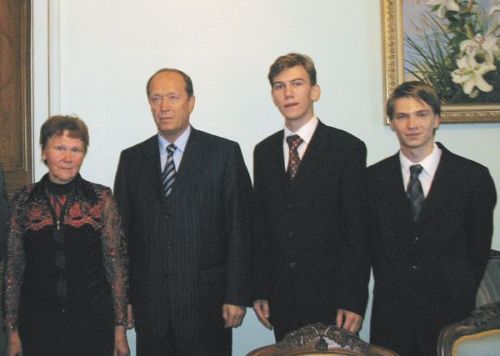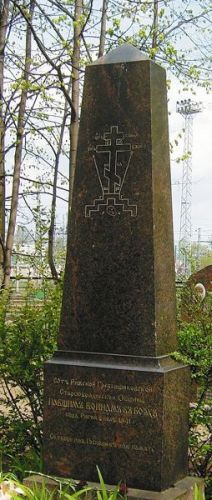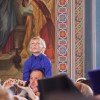Source: Russkiy Mir Foundation
 June of 1941 was hotter than usual, but the residents of Riga tried to stay in their homes as much as possible. Gunshots were heard throughout the city. The first deaths among both civilians and military personnel took place on June 23. But real hell broke loose on the last day of the month…
June of 1941 was hotter than usual, but the residents of Riga tried to stay in their homes as much as possible. Gunshots were heard throughout the city. The first deaths among both civilians and military personnel took place on June 23. But real hell broke loose on the last day of the month…
Fierce firefights broke out on June 30 near the train depot, central prison, Russian cemeteries and along the railroad lines. Each side had about 2000 casualties on this day alone. While the bodies of Wehrmacht soldiers were quickly gathered by the German side, the Red Army soldiers that died defending the Riga remained strewn out under the scorching sun. For several days nobody risked going near them…
Father Nikolai Shalfeev from the Church of St. John, which was located near the railroad, and representatives of the Grebenschikov Old Believers society went to ask the German commander in charge of the city to ask for permission to provide a decent burial for the dead soldiers. Nikolai Shalfeev, who spoke fluent German, was able to convince the new authorities that the bodies should be laid to rest, and he received permission to provide the soldiers a Christian burial.
The priest asked his laymen for assistance, and dozens of volunteers showed up at the depot with carts and carriages… A mass grave for 150 soldiers whose remains could be identified was created at the Orthodox section of the Ivanov cemetery. At the Old Believers cemetery six mass graves were dug for the bodies of over 800 soldiers who could not be identified. Services for the slain were held at the cemeteries, a rather risky affair in a city occupied by fascists.
Georgy Isachenko, who was 14 years old at the time, recalls: “Father Lev Murnikov called on us, the church singers, and said, ‘Today we will hold a liturgy service at the mass grave of Russian soldiers. Truth be told, this is risky, as the German commander gave us permission to bury the dead, but said nothing about a memorial service.’”
Of course they were afraid, but no one refused. There was a large gathering of believers at the ceremony. While it was understood that not all the dead were Orthodox, and that not all Red Army soldiers were religious, the community decided that regardless of who the fallen soldiers were, their parents would be pleased that their final resting place is with their comrades in arms. At least they were given a decent burial.
The Germans, of course, were not happy and told the priest so: what’s all this crying over communisms. However, father Nikolai Shalfeev was once again able to convince the commander that it was simply a matter of churches following Christian rites, and nothing more.
A Holy Man
Father Shalfeev was left in peace for a short period of time. However, he was ready to quit. Based on his requests to the Riga Civil Records Department, 86 death certificates were issued for Soviet soldiers who died in the first days of the war. The records include such notes as: “ruined by a bomb”, “died as a result of military actions”, “gunshot wound”… These notes were found in the archives by Tamara Zitzer, a Riga schoolteacher, who together with her students launched a history project on the first victims of the war among the civilian population and servicemen.
“It’s difficult to imagine… There’s a war going on, bombs are falling, German troops have entered the city, the Gestapo is terrorizing people – every man for himself!” says Tamara Zitzer. “It seems that this old man – Nikolai Shalfeev was already 78 years old – would not be concerned with these dead young men whom he didn’t even know. It would be understandable if following the burial and service for these fallen soldiers he decided to do no more. But to the contrary, he carefully writes down the names and surnames of the soldiers in alphabetical order, goes to the Civil Records Department and demands that a death certificate be issued for each one of them. This is really touching! He was a holy man…”
Together with her pupils, Tamara Zitzer copied the names of the soldiers in the archives and gave them to the Russian Embassy in Latvia. Ambassador Alexander Veshnyakov thanked the teacher and her helpers and noted that this appears to be the first time in modern history that Latvian schoolchildren have taken up the study of the fates of Soviet soldiers in Latvia. Many of those who died were almost the same age as the schoolchildren.
Father Nikolai Shalfeev nonetheless suffered as a result of his good deeds. Someone told the Germans that he had helped save Jewish children in the Riga ghetto that was located near his church. The Gestapo kept the priest locked up for three months, and died three days after being released – December 28, 1941. He was buried in the Ivanov cemetery not far from the mass grave of Soviet soldiers.

The Architect
After some time had passed, the laymen of the Orthodox and Old Believers churches started talking about the graves. Some sort of memorial needs to be set up. But what kind? In the midst of the occupation you could think of putting up a red star, the symbol of the Red Army. They decided to order a granite memorial with an Orthodox cross and began collecting funds. But of course this was all done in secret. One of the lead organizers among the Old Believers was Konstantin Portnov, who is remembered by his contemporaries as a well-educated and progressive man.
He taught religious principles at the main Russian school and gymnasium, delivered lectures on the history of the Old Believers, and was one of the initiators of the journal Rodnaya Starina. Konstantin Portnov was well respected to the citizens of Riga, which greatly helped him raise funds for the memorial. Enough money for two monuments, one for each cemetery, was collected rather quickly.
But this begs the question: who would risk putting up a memorial to Red Army soldiers on Nazi-occupied territory? However, such a person appeared. The project was undertaken by Vladimir Shervinsky, a well-known Russian architect in Riga. And he did so without the slightest hesitation.
Long before the start of the war, several Orthodox churches were built in Latvia according to his designs. And as the synod architect of the Latvian Orthodox Church, he helped establish a monument at the Pokrov Cemetery to Russian soldiers who died during the World War I. Some of the best works of Shervinsky include a chapel at the Pokrov cemetery, the only one of his chapels that remains standing today. During the German occupation, Metropolitan Sergei (Voskresensky) appointed Shervinsky a member Exarchate board of the “Pskov Orthodox Mission”. Getting ahead of our story, I can say that this appointment cost dearly later in life – several years in a prison camp in Komi and confiscation of his property.
Eizen Upmanis, the grandson of Vladimir Shervinsky (who died in 1975) told us that his grandfather was well acquainted with Father Nikolai Shalfeev: “Grandfather always spoke of him with the greatest respect. According to him, [Shalfeev] mentioned the possibility of erecting a memorial soon after the burial of the fallen soldiers. But in autumn of 1941, the head of the city, Paul Dreiman, with whom grandfather had studied architecture together, asked him to take up a project to build barracks for Russian POWs. And grandfather told me how he, escorted by German officers, went for the first time to outskirts of the city, where under the open sky lay thousands of POWs, they were dying of hunger. It was a horrible sight. All the trees were stripped bare as high as a human hand could reach. They were eating bark, but even that had run out…”
After seeing this Vladimir Shervinsky not only quickly started in the barracks – as it was getting cold and there was no time to waste – but he also managed to get the authorities to agree to allow the church to collect bread for the prisoners. Food for the Russian prisoners was brought to the Cathedral of the Birth of Christ and then transported out to the prison camp. When the soldiers found out that they were from the Orthodox church, they pleaded to have a priest carry out a church service.
“My grandfather, who was also there, described this scene,” says Eizen. “Thousands of haggard, dirty, hungry and sick soldiers stood and listened to the service, tears running down the faces of many of them. They repeated the words of prayer voiced by Father Kirill, would led the service, and genuflected. They all asked for salvation, some out loud, others in their minds… And mother told me about how they would cut out of Orthodox journals icons and images of saints, glued them to cardboard, had them blessed at church and then passed them along to the camps together with the food. The Germans soon grew weary of this charity, and they under threat of death forbid any assistance to the prisoners of war.”
Crosses on Mass Graves
 The family of Eizen Upmanis, who heads the Mass Grave Committee in Riga and is a leading specialists on mass burials, preserves the design sketches of the monument to the fallen Soviet soldiers that Vladimir Shervinsky erected during the summer of 1942 – at the height of Nazi occupation…
The family of Eizen Upmanis, who heads the Mass Grave Committee in Riga and is a leading specialists on mass burials, preserves the design sketches of the monument to the fallen Soviet soldiers that Vladimir Shervinsky erected during the summer of 1942 – at the height of Nazi occupation…
The Germans were furious: who would dare? The police started hauling in spiritual and civil leaders from the Orthodox and Old Believers communities. The priest were lambasted, insulted and abused… But the Russians stood firm: this was their Christian duty, which is why the eight-pointed cross is on both monuments. And after a while they stopped harassing the priests.
But the Gestapo decided to uncover the guilty among the churchgoers, and they started enquiring about who raised money for the monuments. And that’s how they uncovered the main initiator among the Old Believers – Konstantin Portnov. They also discovered that he had been helping POWs. Portnov and his wife Vera, a teacher of Russian language and literature, were arrested. After several days of torture they were sent to a concentration camp in Salaspils, but they never arrived… They were executed on the way there. The place of their burial is unknown.
The monument at the Old Believers cemetery, which was largely made possible by their efforts, remains standing to this day. The inscription reads: “…to the fallen soldiers in the battle of Riga in June 1941. May they be remembered, good Lord, forever.” One can always find fresh flowers here, and also at the second monument, at the Orthodox cemetery.
When in 1951 architect Vladimir Shervinsky was accused of cooperating with occupational authorities, he told the investigator that he not only built barracks to shelter POWs from the cold, but he also erected a monument to Russian soldiers in 1942. But the investigator was incredulous: “That’s impossible!” And he did not even bother to check.
The architect was convicted and sent to prison camp. And who could believe that during the war in a city occupied by Nazis it was possible to erect a monument to soldiers of the Red Army?
Are there any other such stories?















